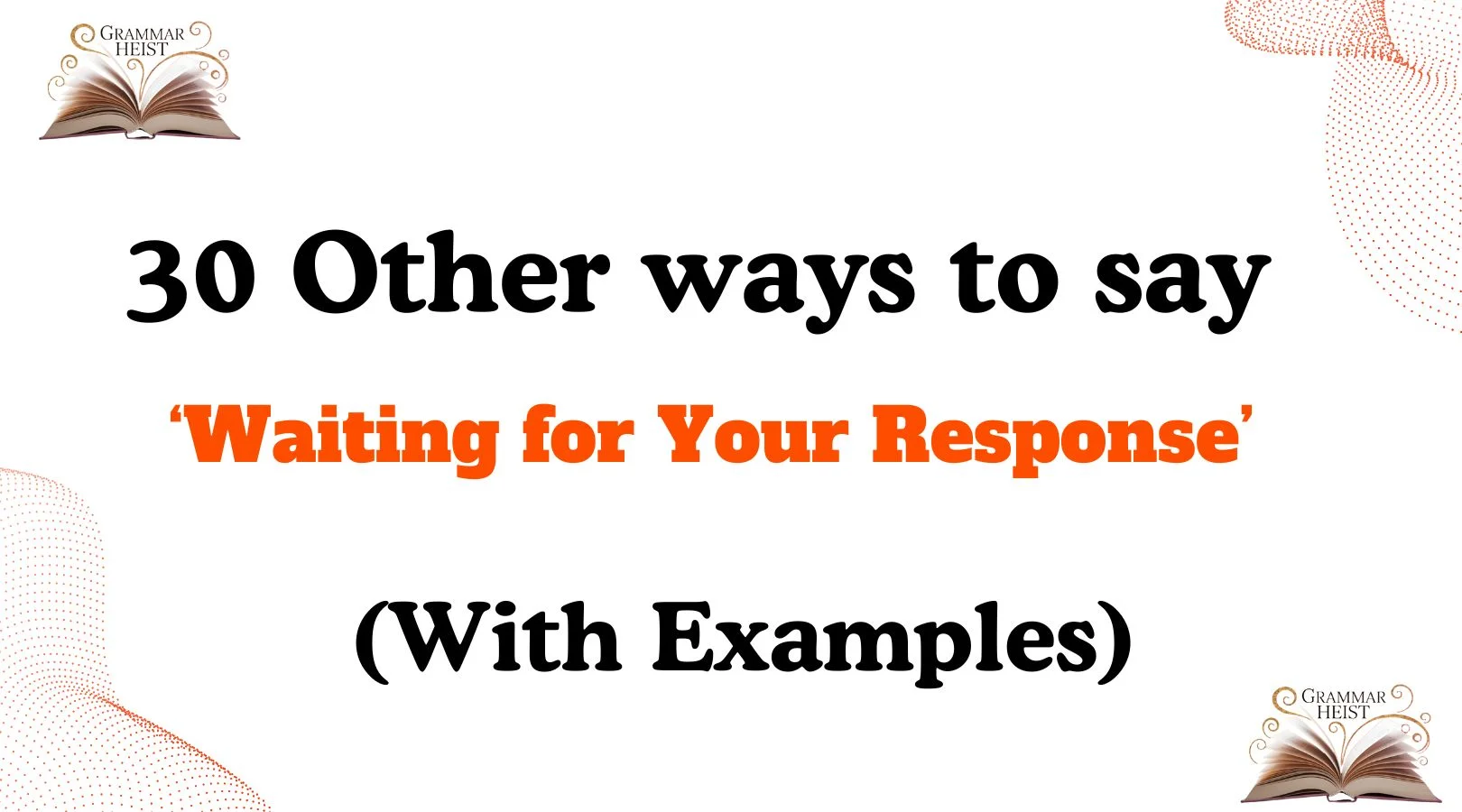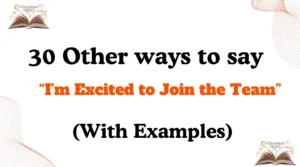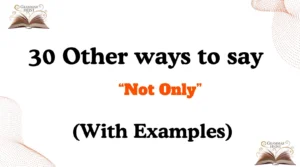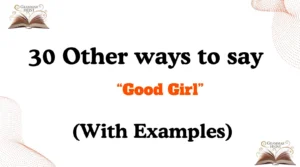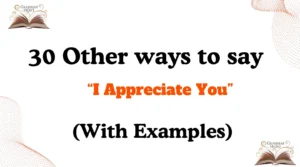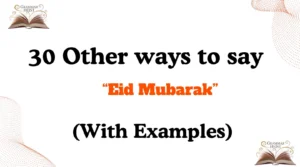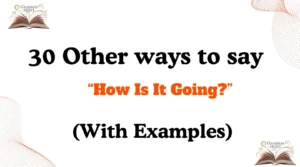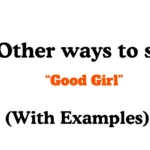Finding the right words when you’re waiting for someone’s response can make a big difference. Instead of sounding impatient or too formal, using thoughtful and warm alternatives can help you communicate with more care. These phrases are not only professional but also add a touch of empathy and friendliness to your message.
In this article, we’ll explore 30 other ways to say “waiting for your response”, with examples, tone explanations, and when to use them in different scenarios.
What Does “Waiting for Your Response” Mean?
The phrase “waiting for your response” is commonly used in emails, texts, and business communication to show that you are expecting a reply. It signals that the conversation is incomplete until the other person responds. However, it can sometimes sound too stiff, formal, or even impatient—which is why finding alternatives matters.
Is It Professional/Polite to Say “Waiting for Your Response”?
Yes, it is professional to say “waiting for your response,” but the tone depends on the relationship and context. In a formal setting, it works fine. But in friendly, empathetic, or client-focused communication, it may feel cold or demanding. Using alternatives allows you to be more polite, approachable, and thoughtful while still expressing that you’re expecting a reply.
Pros or Cons of Using “Waiting for Your Response”
Pros:
- Clear and direct.
- Works well in formal business communication.
- Shows you’re expecting a reply.
Cons:
- Can sound too formal or robotic.
- May come across as impatient.
- Lacks warmth and personal touch.
Synonyms For “Waiting for Your Response”
- Looking forward to your reply
- Eager to hear from you
- I await your feedback
- Hope to hear from you soon
- Kindly respond at your convenience
- Your response will be appreciated
- Hoping for your feedback
- I would love to hear your thoughts
- Awaiting your kind reply
- Looking forward to hearing from you
- Hoping to hear back from you
- I look forward to your feedback
- Waiting eagerly for your reply
- Hoping for your prompt response
- I’m keen to hear your thoughts
- I’ll wait for your reply
- Please let me know your thoughts
- Looking forward to your valuable input
- Awaiting your update
- I look forward to connecting with you
- Your reply will mean a lot
- Please share your feedback
- I’m waiting for your confirmation
- An early reply would be appreciated
- Waiting for your thoughts
- Please get back to me
- I’ll be waiting to hear from you
- Hoping to receive your response soon
- I’d appreciate your reply
- Please let me know at your earliest convenience
1. Looking forward to your reply
Scenario: A polite and optimistic way to end a message.
Examples:
- “I’m looking forward to your reply on this matter.”
- “Looking forward to your reply when you get a chance.”
- “I truly look forward to your reply soon.”
Tone: Friendly, positive, and hopeful.
Explanation: This phrase shows eagerness without sounding pushy. It’s commonly used in both professional and casual communication to leave a warm impression.
2. Eager to hear from you
Scenario: Suitable when you want to show genuine interest or excitement about the reply.
Examples:
- “I’m eager to hear from you about the proposal.”
- “Eager to hear from you once you’ve reviewed.”
- “Always eager to hear from you.”
Tone: Warm, enthusiastic, and engaging.
Explanation: This phrase communicates excitement and genuine curiosity. It works well when you want to make the other person feel valued.
3. I await your feedback
Scenario: Best for formal or professional settings where you’re expecting structured input.
Examples:
- “I await your feedback on the attached report.”
- “I await your feedback regarding the next steps.”
- “Eagerly, I await your feedback on this matter.”
Tone: Formal, respectful, and professional.
Explanation: This phrase is ideal in work-related contexts. It sets a clear expectation for feedback without adding pressure.
4. Hope to hear from you soon
Scenario: Used when you want to gently encourage a timely reply.
Examples:
- “I hope to hear from you soon regarding the meeting.”
- “Hope to hear from you soon after reviewing the file.”
- “Looking forward and hope to hear from you soon.”
Tone: Polite, caring, and slightly time-sensitive.
Explanation: This phrase strikes a balance between friendliness and professionalism. It’s softer than “waiting for your response” but still encourages action.
5. Kindly respond at your convenience
Scenario: Suitable for formal communication where patience is important.
Examples:
- “Kindly respond at your convenience regarding the schedule.”
- “Please kindly respond at your convenience.”
- “I’ll wait for you to kindly respond at your convenience.”
Tone: Respectful, professional, and patient.
Explanation: This phrase shows understanding and flexibility, leaving the recipient free to reply when they can, without pressure.
6. Your response will be appreciated
Scenario: When you want to show gratitude in advance.
Examples:
- “Your response will be appreciated regarding this request.”
- “I’ll wait—your response will be appreciated.”
- “Your response will be appreciated as soon as possible.”
Tone: Courteous, grateful, and professional.
Explanation: This option makes your message polite while reminding the reader that their reply matters.
7. Hoping for your feedback
Scenario: When you want to invite someone’s opinion or review.
Examples:
- “I’m hoping for your feedback on the presentation.”
- “Hoping for your feedback at your earliest convenience.”
- “Always hoping for your feedback to improve.”
Tone: Gentle, warm, and open.
Explanation: This phrase communicates openness and shows that you value the other person’s input.
8. I would love to hear your thoughts
Scenario: Great for teamwork, collaboration, or personal discussions.
Examples:
- “I would love to hear your thoughts on this project.”
- “Always open—I’d love to hear your thoughts.”
- “Before moving forward, I’d love to hear your thoughts.”
Tone: Friendly, engaging, and inviting.
Explanation: This makes communication more personal, showing interest in what the other person has to say rather than just waiting.
9. Awaiting your kind reply
Scenario: Best for formal or polite professional requests.
Examples:
- “Awaiting your kind reply regarding the quotation.”
- “I remain awaiting your kind reply.”
- “Awaiting your kind reply on the matter.”
Tone: Polite, formal, and respectful.
Explanation: Commonly used in business emails, it expresses patience and courtesy while waiting for the recipient’s response.
10. Looking forward to hearing from you
Scenario: A warm and commonly used alternative for everyday communication.
Examples:
- “Looking forward to hearing from you about the job opportunity.”
- “Always looking forward to hearing from you.”
- “I’m looking forward to hearing from you at your convenience.”
Tone: Friendly, approachable, and polite.
Explanation: This phrase is one of the most versatile and positive options, perfect for both formal and casual settings.
11. Hoping to hear back from you
Scenario: A simple and friendly reminder for a reply.
Examples:
- “I’m hoping to hear back from you this week.”
- “Hoping to hear back from you after your review.”
- “Always hoping to hear back from you soon.”
Tone: Warm, hopeful, and conversational.
Explanation: This phrase sounds less formal but still shows that you are waiting politely.
12. I look forward to your feedback
Scenario: Useful when you are asking for input or opinions.
Examples:
- “I look forward to your feedback on this draft.”
- “Looking forward to your feedback on my proposal.”
- “I truly look forward to your feedback.”
Tone: Polite, professional, and constructive.
Explanation: This phrase makes your request sound like a collaborative opportunity rather than a demand.
13. Waiting eagerly for your reply
Scenario: When you want to show enthusiasm and urgency.
Examples:
- “I’m waiting eagerly for your reply on this matter.”
- “We are waiting eagerly for your reply to proceed.”
- “Waiting eagerly for your reply after review.”
Tone: Energetic, enthusiastic, and slightly urgent.
Explanation: Best used in situations where quick feedback is needed, while still sounding positive.
14. Hoping for your prompt response
Scenario: When you want a reply without unnecessary delay.
Examples:
- “I am hoping for your prompt response to move forward.”
- “Hoping for your prompt response regarding the update.”
- “I’ll be hoping for your prompt response soon.”
Tone: Formal, respectful, and time-sensitive.
Explanation: This phrase is suitable for urgent requests but keeps the message professional and courteous.
15. I’m keen to hear your thoughts
Scenario: Great for collaboration or creative discussions.
Examples:
- “I’m keen to hear your thoughts on the idea.”
- “Always keen to hear your thoughts on improvements.”
- “I’m keen to hear your thoughts before finalizing.”
Tone: Engaging, friendly, and open.
Explanation: Shows genuine curiosity and values the recipient’s perspective.
16. I’ll wait for your reply
Scenario: Straightforward and clear for both formal and informal use.
Examples:
- “I’ll wait for your reply to confirm.”
- “I’ll wait for your reply before making changes.”
- “I’ll wait for your reply as suggested.”
Tone: Direct, patient, and professional.
Explanation: A simple and neutral alternative that sets the expectation for a response.
17. Please let me know your thoughts
Scenario: Inviting input in a friendly but professional way.
Examples:
- “Please let me know your thoughts on this draft.”
- “I’d appreciate it if you let me know your thoughts.”
- “Please let me know your thoughts when possible.”
Tone: Respectful, polite, and approachable.
Explanation: Encourages collaboration and shows you’re open to discussion.
18. Looking forward to your valuable input
Scenario: Suitable when you want to highlight the importance of someone’s response.
Examples:
- “Looking forward to your valuable input on this project.”
- “Your valuable input is awaited eagerly.”
- “I’m looking forward to your valuable input soon.”
Tone: Respectful, appreciative, and professional.
Explanation: This phrase shows gratitude while stressing that their opinion matters.
19. Awaiting your update
Scenario: Best for business communication when tracking progress.
Examples:
- “I’m awaiting your update on the client request.”
- “Awaiting your update before the next step.”
- “We are awaiting your update on the issue.”
Tone: Direct, formal, and business-like.
Explanation: Keeps communication professional and focused on progress.
Read More:30 Other Ways to Say ‘Thank You for Your Cooperation’ (With Examples)
20. I look forward to connecting with you
Scenario: Often used in networking or professional introductions.
Examples:
- “I look forward to connecting with you after your review.”
- “Looking forward to connecting with you regarding the proposal.”
- “I truly look forward to connecting with you.”
Tone: Warm, polite, and optimistic.
Explanation: A friendly alternative that makes communication feel more relational than transactional.
21. Your reply will mean a lot
Scenario: When you want to add a personal or emotional touch.
Examples:
- “Your reply will mean a lot to me.”
- “Your reply will mean a lot as we move forward.”
- “Your reply will mean a lot in making the decision.”
Tone: Warm, sincere, and appreciative.
Explanation: This phrase emphasizes the value of their response, making the message more heartfelt.
22. Please share your feedback
Scenario: Directly asking for input or suggestions.
Examples:
- “Please share your feedback on the document.”
- “I’d love it if you could share your feedback.”
- “Please share your feedback when convenient.”
Tone: Polite, open, and professional.
Explanation: A clear way to request input while showing respect for the other person’s time.
23. I’m waiting for your confirmation
Scenario: Best for tasks, bookings, or agreements.
Examples:
- “I’m waiting for your confirmation on the schedule.”
- “Waiting for your confirmation before proceeding.”
- “I’m still waiting for your confirmation on this matter.”
Tone: Professional, precise, and direct.
Explanation: Ideal for situations where a reply is required to move forward with an action.
24. An early reply would be appreciated
Scenario: When you politely want a faster response.
Examples:
- “An early reply would be appreciated to finalize the report.”
- “An early reply would be appreciated on this request.”
- “If possible, an early reply would be appreciated.”
Tone: Respectful, formal, and time-conscious.
Explanation: Helps express urgency politely, without appearing pushy.
25. Waiting for your thoughts
Scenario: A soft way of expecting a reply, especially in creative discussions.
Examples:
- “I’m waiting for your thoughts on this proposal.”
- “Still waiting for your thoughts before I continue.”
- “I’ll be waiting for your thoughts on the update.”
Tone: Friendly, casual, and open.
Explanation: Works well in informal professional settings where the relationship is already comfortable.
26. Please get back to me
Scenario: A straightforward, everyday expression.
Examples:
- “Please get back to me when you have time.”
- “I’d appreciate it if you could get back to me soon.”
- “Please get back to me with your response.”
Tone: Direct, casual, and polite.
Explanation: Simple and clear, commonly used in both work and personal contexts.
27. I’ll be waiting to hear from you
Scenario: A gentle way to remind the other person you expect a reply.
Examples:
- “I’ll be waiting to hear from you before moving forward.”
- “I’ll be waiting to hear from you on this matter.”
- “I’ll be waiting to hear from you after your review.”
Tone: Patient, respectful, and polite.
Explanation: This phrase shows you’re willing to wait without pressuring the recipient.
28. Hoping to receive your response soon
Scenario: A polite follow-up option with a sense of urgency.
Examples:
- “I’m hoping to receive your response soon.”
- “Hoping to receive your response soon regarding the proposal.”
- “Always hoping to receive your response soon.”
Tone: Polite, professional, and slightly urgent.
Explanation: Suitable when a faster reply is preferred but you still want to sound respectful.
29. I’d appreciate your reply
Scenario: Used when showing gratitude in advance.
Examples:
- “I’d appreciate your reply on this request.”
- “Always would appreciate your reply when possible.”
- “I’d truly appreciate your reply at your convenience.”
Tone: Courteous, grateful, and professional.
Explanation: Expresses thankfulness while still keeping the message professional.
30. Please let me know at your earliest convenience
Scenario: Professional and formal way to request a timely response.
Examples:
- “Please let me know at your earliest convenience.”
- “I’d be grateful if you let me know at your earliest convenience.”
- “Please let me know your decision at your earliest convenience.”
Tone: Formal, polite, and respectful.
Explanation: Commonly used in business communication, this phrase balances urgency with politeness.
Conclusion
When communicating, the way you phrase “waiting for your response” can completely change how your message is received. While the original phrase is clear, it may sometimes feel too formal or robotic. By using thoughtful alternatives, you show respect, warmth, and empathy—making your communication more effective and human.

Emma Brooke is a passionate advocate for effective communication and language mastery. As a dedicated professional in the field of grammar and writing, Emma brings a wealth of knowledge and expertise to those seeking to improve their linguistic skills. With a focus on clarity, precision, and style, Emma Brooke is committed to helping individuals refine their language use to communicate confidently and effectively.
